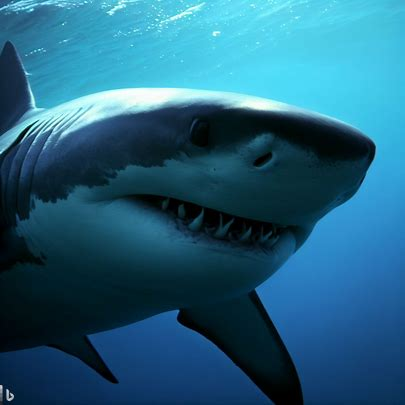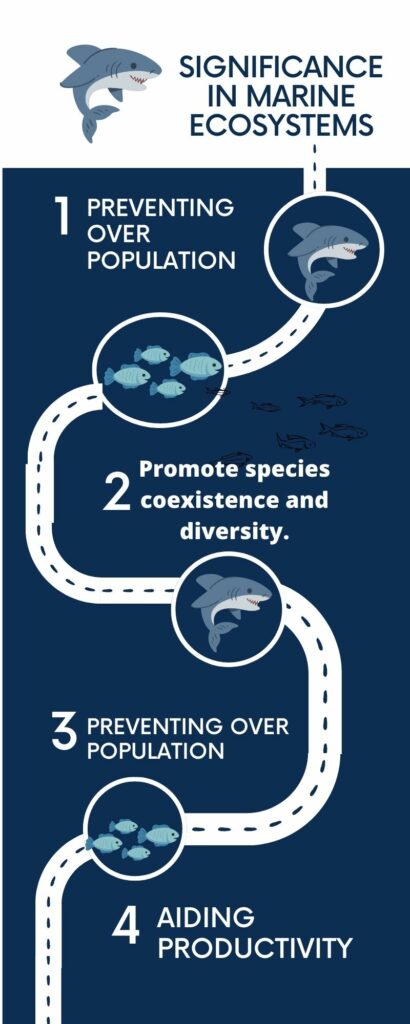
Key Takeaways:
- Great white sharks play a crucial role in maintaining the balance of marine ecosystems.
- They are apex predators and help control the population of other marine species.
- Great white sharks are highly adapted and have evolved over millions of years to become efficient hunters.
- Their presence in the ocean indicates a healthy and thriving ecosystem.
- Conservation efforts should focus on protecting great white sharks to ensure the overall health of marine environments.
- Understanding the behavior and biology of great white sharks can help mitigate human-shark interactions and reduce the risk of shark attacks.
- Great white sharks are not mindless killers but rather intelligent and complex creatures that deserve respect and protection.
Great White Sharks have long been intriguing to scientists and marine fanatics. Their intimidating presence and powerful hunting make them feared and respected. But is there more to them than being top predators? Are Great White Sharks keystone species?
A keystone species is an organism that has a disproportionate impact on its environment, being critical for the balance of the whole community. It implies that the presence or absence of Great White Sharks can massively affect the health and biodiversity of their habitat.
Studies show that Great White Sharks are vital for keeping prey populations like seals and sea lions in check. They target the weak and sick, preventing disease outbreaks and promoting the survival of the fittest.
Furthermore, Great White Sharks are indicators of oceanic health. If their numbers decline or they go missing, it could be a sign of bigger ecological problems like overfishing or pollution. Therefore, studying these creatures can give us great insight into the well-being of our seas.
Pro Tip: We must protect not only Great White Sharks but also their delicate habitats, as it’s clear they are keystone species; if they go, the whole ecosystem collapses.
Understanding Keystone Species
Great white sharks – feared predators of the ocean – are also keystone species. They keep prey populations in check, by preying on medium-sized predators and controlling their numbers. This helps maintain balance in the ecosystem.
These apex predators also scavenge on carcasses or eat sick and weak animals, keeping diseases from spreading. Studies show that their presence can even lead to changes in location and feeding patterns for both prey and competing species.
A study, published in Ecology Letters by Ferretti et al., 2010, identified great white sharks as key regulators of biodiversity in marine environments. They have a significant ecological impact and play an essential role in maintaining ecosystem stability.
Characteristics of Keystone Species
To understand the characteristics of keystone species, delve into their vital role in ecosystems and explore various examples of such species. Their contribution to the overall balance and health of their habitats is instrumental.
Role in Ecosystems
Keystone species are the VIPs of the animal kingdom! They play a vital role in keeping ecosystems balanced and stable. They have a huge influence on the way the environment looks and works. One special thing about them is their ability to control the population sizes of other species. By managing predator-prey relationships and controlling resources, they make sure other organisms stay safe and healthy.
Plus, keystone species increase biodiversity by doing important jobs like pollination and seed dispersal. They also make ecosystems more robust and able to handle change. Some keystone species are even ecosystem engineers, reshaping their habitats by digging or building structures.
The real kicker? Keystone species have a much bigger effect than their numbers suggest. Even if they’re not the most common, their presence or absence can cause huge changes. For example, taking away a keystone predator can cause a chain reaction, leading to too many prey animals and not enough food.
Take the sea otter (Enhydra lutris) for instance. They’re a keystone species in Pacific kelp forests. By eating sea urchins, they stop them from overgrazing the kelp. This shows how one species can shape an entire marine ecosystem.
Examples of Keystone Species
Keystone species are essential for maintaining balance and stability in ecosystems. They have a larger effect than their number suggests. Here are some examples of keystone species with their roles:
| Species | Role |
|---|---|
| Sea otters | Feed on sea urchins, preserving kelp forests. |
| Beavers | Build dams, creating wetlands to support wildlife. |
| Wolves | Manage prey numbers, helping vegetation. |
| Pronghorn antelope | Maintain grassland health through browsing and seed dispersal. |
| Corals | Home to many marine species, offering coastal protection. |
There are other keystone species too, like prairie dogs. Their burrowing aerates the soil, allowing other organisms to thrive.
A great example of the importance of keystone species is the reintroduction of wolves into Yellowstone National Park. This brought about changes from overgrazing by elk, to more streamside vegetation. The ecosystem was greatly improved.
Keystone species show us the complexity of ecological systems. Their presence or absence can have huge impacts, making them invaluable.
Great White Sharks as Potential Keystone Species
To understand the potential role of great white sharks as keystone species, explore their impact on habitat and distribution, prey and predation patterns, and their significance in marine ecosystems. Delve into how these aspects shape the delicate balance of the oceanic environment.
Habitat and Distribution
The great white sharks’ preferences for coastal regions with temperate and tropical waters, such as the Eastern Pacific Ocean, South Africa, and Australia, with high fish populations like rocky reefs & seal colonies, is widely known. Their distribution spans different oceans, in both offshore and nearshore environments.
Migratory patterns take them to feeding grounds and breeding areas over vast distances. Environmental factors, such as water temperature, salinity levels, and prey availability, influence their presence in certain areas.
These apex predators help maintain the balance of marine ecosystems by regulating the population of prey species. Plus, they utilize specific migratory routes over a long period of time without much deviation.
Therefore, it is important to consider their habitat and distribution when creating conservation strategies for both them and the marine ecosystems. Bon appétit!
Prey and Predation Patterns
Great White Sharks are true predators of the sea! They prowl the oceans in search of fish, seals, sea lions, and even smaller sharks. Their sharp teeth and powerful jaws make them a force to be reckoned with.
Let’s take a look at their impact on marine ecosystems through some intriguing stats:
| Prey | Predators | Importance in Ecosystem |
| Fish | Great White Sharks | Population regulation |
| Seals & Sea Lions | Great White Sharks | Controlled population growth |
| Smaller Sharks | Great White Sharks | Maintenance of ecological balance |
These interactions between great white sharks and their prey are essential for keeping marine ecosystems healthy. Overfishing and habitat destruction have led to a decline in their population, so conservation efforts are necessary.
Here’s what we can do to protect these keystone predators:
- Stricter fishing regulations: Limiting the capture of their prey will ensure their food supply remains intact.
- Marine protected areas: These safe havens will help their prey populations recover and sustain.
- Raising awareness: Educating people about the importance of great white sharks in marine ecosystems is vital. Responsible tourism must be encouraged to help preserve their habitats.
Let’s recognize their status as potential keystone species and take steps to protect them for the future of our oceans.
Significance in Marine Ecosystems
Great White Sharks are truly incredible! They have a huge impact on marine ecosystems and are considered potential keystone species. Let’s explore their significance in maintaining ecological balance.
They regulate prey populations, preventing overpopulation and preventing overpopulation. Also, their position as apex predators helps promote species coexistence and diversity. And, with their feeding habits, they transport nutrients from one area to another, aiding productivity.
These majestic creatures possess unique characteristics that contribute to their importance. Their strong senses, such as electroreception and olfaction, help them find prey and keep food chains active. Plus, their wide range distributes prey populations and connects habitats.
The story of the California seal population decline proves how powerful they are. In 1997, a team of researchers observed a decrease in seals along the coast. After further inspection, they found orcas were preying on a particular species of seals that lived further offshore. This decreased predation pressure on Great White Sharks closer to shore, leading to a surge in their population near human-inhabited beaches.

To sum it up, Great White Sharks play an essential role in marine ecosystems as potential keystone species. By controlling prey populations, promoting biodiversity maintenance, and redistributing nutrients, they help maintain the delicate balance of ocean health and vitality.
Arguments Supporting Great White Sharks as Keystone Species
To understand the arguments supporting great white sharks as keystone species, delve into their crucial role in the ecosystem. Explore how they influence prey behavior, impact trophic cascades, and inspire conservation efforts and protection. Discover the significance of their presence and the ripple effects it has on the entire marine ecosystem.
Influence on Prey Behavior
Great white sharks have a powerful influence on their prey’s behavior. Just their presence alone can change how prey species act, resulting in entire ecosystems being shaped. Let’s look closer at the influence they have on prey.
Behavioral Change:
- Migratory Patterns: Prey species alter their migratory paths to dodge areas full of great white sharks.
- Feeding Habits: Prey become more cautious when feeding and avoid spots where the sharks can be seen.
- Social Dynamics: The pressure of predation from great white sharks causes changes in the social structure of prey.
- Hiding and Defense Mechanisms: Prey increases their chances of survival by improving their hiding and defense strategies.
These changes show the extent of the great white sharks’ effect on marine ecosystems. Even the lack of sharks can throw off the balance due to human activities. To protect our delicate marine ecosystems, it is important to understand the influence of keystone species like great white sharks.
Impact on Trophic Cascades
Great white sharks have a huge impact on trophic cascades. They regulate the populations of their prey, keeping balance and stability in marine food webs.
A table displays the effect of great white sharks:
| Great White Sharks | Prey Population Control |
|---|---|
| Apex Predators | Regulate population of marine mammals (seals, sea lions) |
| Mesopredators | Control population of smaller fish |
| Smaller Fish | Impact zooplankton abundance |
By preying on apex predators, like seals and sea lions, great white sharks control their population. This decreases the biomass of mesopredators, such as smaller fish, which then impacts the amount of zooplankton.
Not only are great white sharks important for the environment, they also have cultural and economic value. They attract tourists who want to observe them in their natural habitat. Plus, where they’re protected, there’s an increase in tourism revenue.
University of California Santa Cruz researchers discovered that great white sharks are a keystone species due to their major influence on trophic cascades. That’s why it’s essential to protect them. They deserve a chance just like any other guest at a wedding – even the one hogging the buffet!
Conservation Efforts and Protection
Conservation of great white sharks is essential for marine ecosystem balance. Initiatives such as Marine Protected Areas, fishing regulations, educational campaigns, collaboration with researchers and involvement of local communities have been taken. Satellite tracking technology has been pivotal for understanding movements and habitat preferences.
We must keep our conservation efforts going – research, regulations, and responsible tourism. Thus, we can save these majestic creatures from disappearing! Also, great whites have sharp teeth and a fearsome rep – but hey, at least they keep annoying seals in check.
Counterarguments and Criticisms
To counter the arguments and criticisms surrounding the idea of great white sharks as keystone species, explore alternative explanations and consider the limitations and challenges in studying keystone species. By analyzing these aspects, gain a more comprehensive understanding of the topic’s complexities and potential flaws.
Alternative Explanations
Alternative explanations can provide fresh perspectives and challenge existing beliefs. They can open up debate, foster intellectual diversity, and advance knowledge. To get the most out of them, it is important to be open-minded and inclusive. Interdisciplinary collaborations and expansive literature reviews can help uncover hidden connections. If studying keystone species was easy, they would just give out doctorates in ‘Keystoneology’ at the drive-thru!
Limitations and Challenges in Studying Keystone Species
Studying keystone species presents limitations and challenges. Identifying them can be hard due to their complex interactions within the ecosystem. Research requires resources and funding since it involves long-term observations and data collection. Ethical considerations arise when studying them, as interventions or experiments may have unintended consequences.
Habitat requirements of keystone species make them complex to study. They often rely on specific environmental conditions or particular prey items. This means research must be conducted in diverse ecosystems to gain a holistic understanding.
One example is the gray wolf in Yellowstone National Park. Wolves’ presence led to changes in elk behavior and habitat use, resulting in a cascade effect throughout the food web. This demonstrates how studying keystone species can uncover unexpected ecological dynamics.
Robert T. Paine’s experiments in the 1960s focused on intertidal communities. He revealed the role of starfish as keystone predators. His work revolutionized our understanding of ecological systems and highlighted the importance of studying keystone species for conservation.
Reminder: Opinions are like belly buttons – everyone has one, but not all of them are worth showing off.
Frequently Asked Questions
1. Are great white sharks considered keystone species?
Yes, great white sharks are indeed considered keystone species in marine ecosystems. They play a crucial role in maintaining the health and balance of their respective habitats.
2. What does it mean for a species to be a keystone species?
A keystone species is one that has a disproportionate impact on its ecosystem compared to its abundance. Their presence or absence can significantly influence the structure and functioning of the entire ecosystem.
3. How do great white sharks contribute as keystone species?
As apex predators, great white sharks regulate other species’ populations by preying on them. This helps maintain the balance of the food web and prevents certain species from dominating the ecosystem.
4. Do great white sharks have any indirect effects as keystone species?
Yes, great white sharks have indirect effects on their ecosystem as well. By controlling the abundance of prey species, they indirectly influence the distribution and behavior of other organisms, including those at lower trophic levels.
5. What would happen if great white sharks were to be extirpated?
If great white sharks were to disappear from an ecosystem, it could have cascading effects throughout the food chain. There could be a population surge in some prey species, leading to the depletion of their prey, and disrupting the entire ecosystem’s balance.
6. How can we protect great white sharks as keystone species?
To protect great white sharks as keystone species, it is crucial to establish and enforce conservation measures. This includes implementing fishing regulations, creating protected marine areas, and raising awareness about the importance of their preservation.
Conclusion
The significance of great white sharks as keystone species in marine ecosystems has been explored in this article. They are apex predators and have a top-down impact on food webs. They control prey populations and influence the behavior and distribution of other species. They also contribute to nutrient cycling by scavenging dead animals. Areas with healthy populations of great white sharks usually have increased biodiversity. It suggests that they have far-reaching effects on ecosystem structure and function. There are documented encounters between humans and great white sharks dating back centuries. These tales remind us of the awe-inspiring nature and our complex relationship with these apex predators throughout history. References – Because even sharks need to cite their sources, especially when swimming upstream against the current controversial keystone species debates.
References




